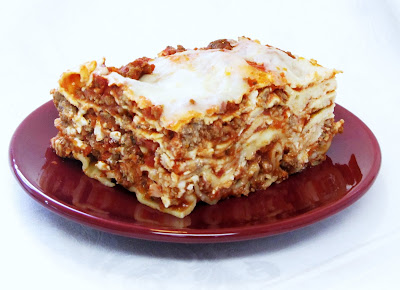Beef Osso Buco with Polenta
How lucky we are to have multiple sources for local, naturally raised, grass-fed and grass-finished beef! I recently spotted several packages of Cascade Natural Meats beef osso buco, in the freezer case at Umpqua Local Goods and decided I needed to try something new. Osso Buco (generally pronounced AW-soh BOO-koh in Italian and OH-soh BOO-koh in English) means “pierced bone” or “hole in the bone”. It's a Milanese dish traditionally made with crosscut veal shanks, though it can also be made with pork or beef.
The meaty beef shanks I bought look
like miniature pot roasts and are cooked in much the same way, long
and slow with plenty of liquid to help tenderize the meat. Like an
“O-bone” or “arm-bone” roast, the marrow in the bone enriches
the flavor of the resulting sauce or gravy. The shanks are dusted
with flour, browned in hot oil, and then braised in stock or a
combination of stock and wine until very tender, from one and a half
to three hours, depending on size. This can be done on the stove or
in the oven, without much attention.
And that's a good thing, too, because
Osso Buco is traditionally served with polenta or risotto, each
requiring 30 to 45 minutes of constant stirring to achieve a creamy
consistency without lumps or burning. I chose polenta because it
reminds me of the grits my Aunt Connie makes when I visit her in
South Carolina, though hers are always made with white corn. I bought
the polenta (medium grind yellow cornmeal) in the bulk aisle at
Sherm's and chose organic because, without labeling, that's the only
way to be sure that it was not made with GMO corn. Less demanding,
but still delicious alternatives would be egg fettucini or even
mashed potatoes. Add a green salad and a crusty baguette to round out
the meal and dinner is served.
Beef Osso Buco
Serves four
3 lbs. meaty beef shanks
¼ cup all-purpose flour
cotton kitchen twine
2 tablespoon butter
2 tablespoon olive oil
1 stalk celery, diced
1 small onion, diced
1 large carrot, diced
3 cloves garlic, minced or pressed
1 cup red wine (or an additional cup of
bouillon)
2-3 cups beef stock or bouillon
salt and freshly ground pepper
1 bay leaf
1 teaspoon dried thyme
1 cup petite-diced canned tomatoes
Preheat the oven to 375 degrees. On the
stove, heat butter and oil in a cast iron or enamel Dutch oven that
has a tight-fitting lid. Tie a piece of twine snugly around each beef
shank to keep it from falling apart while it cooks. Dust both sides
of the meat with flour and shake off the excess. When the butter is
foamy, sear the shanks on all sides until nicely browned and then
remove them to a plate. Add the celery, onion, and carrot to the
Dutch oven and cook until the onion is almost translucent. Add the
minced garlic and cook another minute or two. Add the wine or 1 cup
of the stock to the pan and bring to a boil. Cook over medium-high
heat for 8 to 10 minutes, until the liquid is reduced by half.
Place
the beef shanks on top of the vegetables and pour in enough
additional stock so that it comes three quarters of the way up the
sides of the shanks. Salt and pepper the meat, sprinkle evenly with
the thyme and place one half of the bay leaf on the meaty portion of
each shank. Pour the tomatoes over the top of the meat and bring to a
boil. Cover and place in the oven for 2 ½ to 3 hours, until the meat
is fork-tender.
When ready to serve, remove the bay leaves, carefully
lift out the shanks with a sturdy pancake turner to a warm platter.
Remove the string and place a portion of each shank atop a serving of
polenta in a wide, shallow bowl. Spoon the vegetables and stock over
the top. Note: veal or pork shanks are small and you would serve a
whole shank intact, including the bone, to each person. Beef shanks
are so large they need to be divided.
Basic Polenta
four servings
4 cups water
¾ teaspoon salt
1 cup polenta
2 tablespoons butter
Bring the water to a boil in a
heavy-bottomed pot. Add the salt and then very slowly add the
polenta, whisking constantly to prevent lumps from forming. Reduce
heat and continue cooking and stirring for about 30 minutes, until
the polenta is creamy. (This is a good time to check facebook on your
phone or read a few chapters of a book while you stir.) Taste and add
additional salt, if needed, then stir in the butter. If you are not
serving it immediately, keep the polenta warm and soft for up to one
hour by covering the pot and placing it over a larger pot of barely
simmering water.




